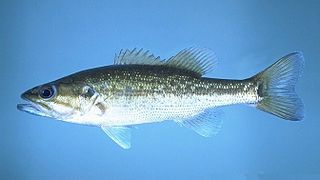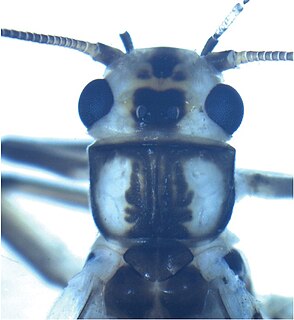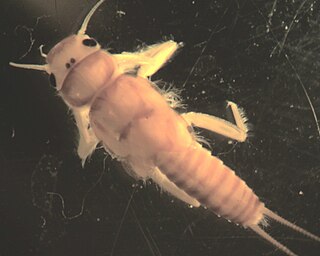
The spotted bass, also called spotty, or spots in various fishing communities, is a species of freshwater fish of the sunfish family (Centrarchidae) of the order Perciformes. One of the black basses, it is native to the Mississippi River basin and across the Gulf states, from central Texas through the Florida panhandle. Its native range extends into the western Mid-Atlantic states and it has been introduced into western North Carolina and Virginia. It has also been introduced to southern Africa, where it has become established in some isolated waters. It is often mistaken for the similar and more common largemouth bass.

The Redeye bass, Redeye, or Coosa Bass is a species of freshwater fish in the sunfish family (Centrarchidae) native to the Coosa River system of Georgia, Alabama. The waters it is normally found in are cool streams and rivers in the foothills of mountains.

Coosa County is located in the east central portion of the U.S. state of Alabama. As of the 2010 census the population was 11,539. Its county seat is Rockford. Its name derives from a town of the Creek tribe and the Coosa River, which forms one of the county borders.

Elmore County is a county located in the east central portion of the U.S. state of Alabama. As of the 2010 census, the population was 79,303. Its county seat is Wetumpka. Its name is in honor of General John A. Elmore.

Rockford is a town in Coosa County, Alabama, United States. At the 2010 census the population was 477. The town is the county seat of Coosa County and is part of the Talladega-Sylacauga Micropolitan Statistical Area.

Wetumpka is a city in and the county seat of Elmore County, Alabama, United States. At the 2010 census the population was 6,528. In the early 21st century Elmore County became one of the fastest-growing counties in the state. The city is considered part of the Montgomery Metropolitan Area.

The Coosa River is a tributary of the Alabama River in the U.S. states of Alabama and Georgia. The river is about 280 miles (450 km) long.

Logan Martin Lake is a reservoir located in east central Alabama on the Coosa River approximately 30 miles (48 km) east of Birmingham, Alabama. This 17,000-acre (69 km2) reservoir was built in 1965 by Alabama Power Company. The lake, nicknamed Lake of a Thousand Coves by locals, has 275 miles (443 km) of shoreline along its 48.5-mile (78.1 km) length sandwiched between Logan Martin Dam on the south and Neely Henry Dam on the north. The depth of the lake is 35 to 110 feet (34 m) with only five feet average water level variance. Logan Martin Lake offers boating, skiing and swimming.

Vogel State Park is a 233-acre (0.94 km2) or 94 hectares state park located at the base of Blood Mountain in the Chattahoochee National Forest. It became one of the first two parks in Georgia when it founded a state park system in 1931. Much of the park was constructed by the Civilian Conservation Corps during the 1930s.

Coosa Bald, with an elevation of 4,280 feet (1,300 m), is tied with Double Spring Knob as the tenth-highest peak in Georgia. It is located in Union County and is the third-highest mountain in the county, behind Blood Mountain and Slaughter Mountain. Coosa Bald is located in the Chattahoochee National Forest and its peak is crossed by the Duncan Ridge Trail, a trail that connects with the Benton MacKaye Trail and the Appalachian Trail.

The Coosawattee River is a 49.3-mile-long (79.3 km) river located in the northwestern Georgia, United States.

The Perlidae are a family of stoneflies, with more than 50 genera and 1,100 described species. The majority of the Perlidae are found in eastern North America, but they occur worldwide except for Antarctica and parts of Africa. Their lifecycles range between one and three years. They adults emerge in the summer; they are very active and known to be attracted to light sources. They are usually very sensitive to changes in environment.
Pleurobema stabile, the Coosa pigtoe, was a species of freshwater mussel, an aquatic bivalve mollusk in the family Unionidae, the river mussels.

The Coosa darter is a species of freshwater ray-finned fish, a darter from the subfamily Etheostomatinae, part of the family Percidae, which also contains the perches, ruffes and pikeperches. It is endemic to the eastern United States.

Neoperla nigromarginata is a species of stonefly native to the Henan province of China. The forewing measures 11.8 millimeters in males, and 13.4–14.0 millimeters in females. The head is pale yellow to brown with black markings. Legs and antennae are brown. The species name refers to the dark-colored margins of the pronotum. The species is similar in many aspects to Neoperla flagellate and N. tuberculata, but can be distinguished by the size of the aedeagus. The Aedeagal sac and tube are approximately the same length, with the sac being membranous and covered in numerous small spines. A pair of flagella are discernable at the sac's apex.
Neoperla clymene, the coastal stone, is a species of common stonefly in the family Perlidae. It is found in North America.

Neoperla is a genus of common stoneflies in the family Perlidae. There are more than 260 described species in Neoperla.
Neoperla mainensis, the Maine stone, is a species of common stonefly in the family Perlidae. It is found in North America.
Coosa is an unincorporated community in Leake County, in the U.S. state of Mississippi.














